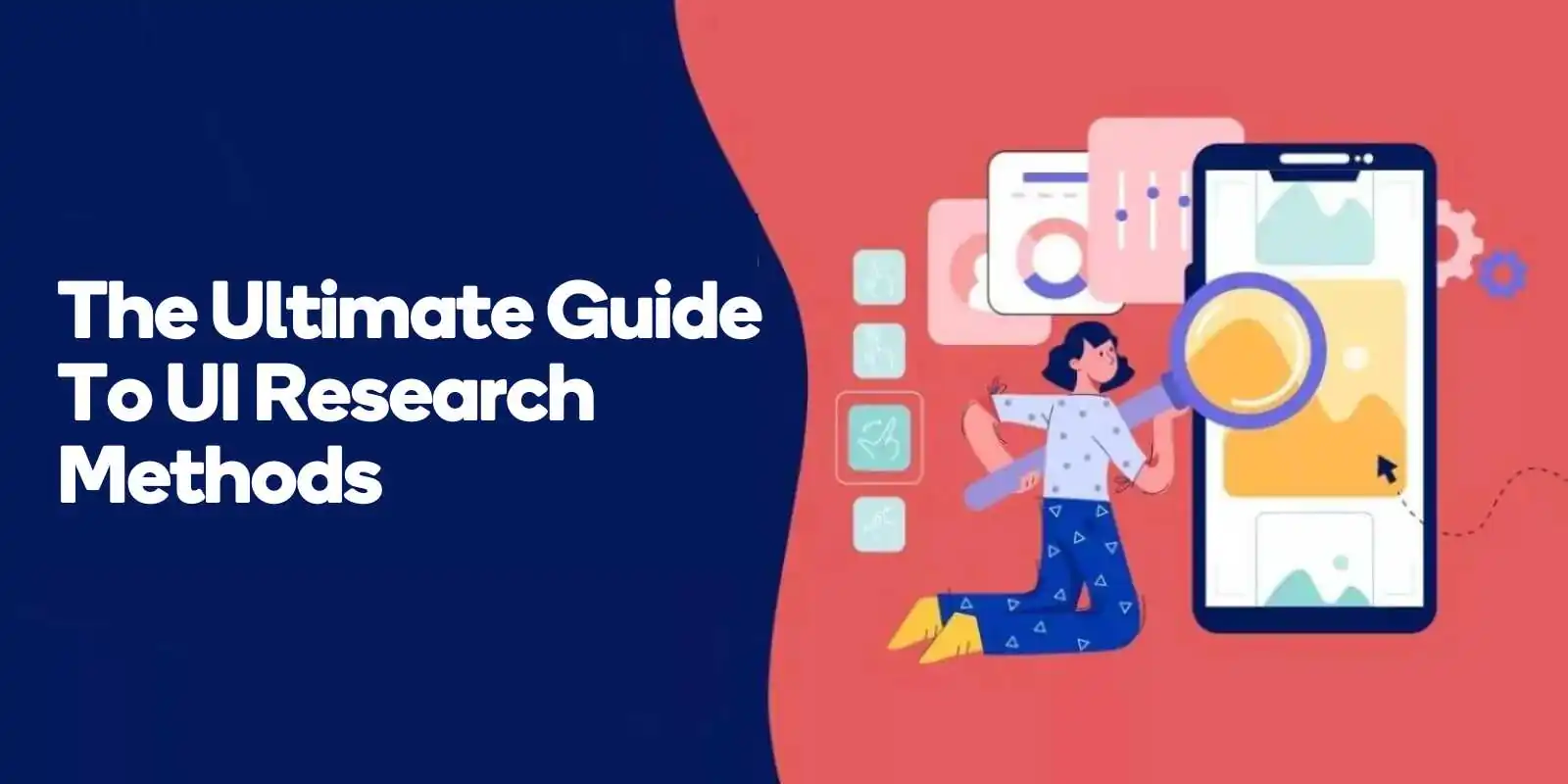In this blog post, we will delve into the world of UI research methods, explore the various types of research techniques, and discuss the top methods that industry experts rely on for creating user-centric designs.
Get ready to embark on a journey to understand the intricacies of UI research methods, learn how to choose the right method based on your project goals and resources, and discover best practices for conducting effective research that yields actionable results.
By the end of this post, you’ll have a comprehensive understanding of the different research techniques and their applications, empowering you to create UI designs that truly resonate with your target audience.
UI Research Methods: An Overview
UX research methods play a crucial role in the design process, offering valuable insights from users and customers that inform product development decisions.
With approximately 15 to 20 common UX research methods available, selecting the right UX research method depends on the project’s objectives, available resources, and design stage.
Some of the leading user research methods and techniques that can provide qualitative data include user interviews, usability testing, A/B testing, surveys and questionnaires, eye tracking, and heatmaps.
Before diving into the specifics of each research method, it’s essential to understand what UI research methods are and why they are important in the design process.
In the following sections, we will define UI research methods, explore their significance, and discuss the different types available to UX designers.
What are UI research methods?
UI research methods involve UX research techniques that are employed to gain insight into users’ interactions with user interfaces, which can be used to create more effective designs and enhance the user experience.
One such UX research method is usability testing. Some of the commonly employed methods for UI design include user interviews, surveys, focus groups, card sorting, and usability testing.
These methods can be categorized into generative research, such as ethnographic research and field studies, which focus on observing users in their natural environment and analyzing their behaviors in specific contexts; and evaluative research methods, which help identify usability issues and validate design decisions.
Understanding the various UI research methods and their applications is essential for UX designers as they navigate through the design process.
The choice of research method should be guided by the project’s objectives, resources, and design stage in order to collect the most relevant data and generate actionable insights.
Why is UI research important?
User research is essential for understanding user needs, preferences, and pain points, thereby guaranteeing that the design fulfills user expectations and offers a smooth experience.
Neglecting UX research can lead to the failure of a product launch, as the design may fail to address user needs and preferences effectively.
By incorporating user research techniques, including UI research, designers can identify user needs, preferences, and areas of difficulty, guaranteeing that the design is in line with user expectations and offers a smooth experience.
Moreover, UI research helps collect both quantitative and qualitative data, providing a comprehensive understanding of how users interact with a product and their underlying motivations.
This information is invaluable for making data-driven design decisions, ensuring that the end product meets or exceeds user expectations.
In the next section, we will delve deeper into the different types of UI research methods and their applications in the design process.
Understanding Different Types of UI Research Methods
The three types of UI research methods are quantitative, qualitative, and mixed-methods. Each type serves a specific purpose and provides unique insights into user interactions with the interface.
Quantitative UI research methods focus on collecting numerical data to measure user behavior, preferences, and trends, while qualitative methods involve gathering non-numerical data to understand user emotions, thoughts, and opinions for informed design decisions.
Mixed-methods UI research combines both quantitative and qualitative approaches to gain a comprehensive understanding of user interactions with the interface.
Understanding the different types of UI research methods and their applications is crucial for UX designers as they strive to create user-centric designs.
In the following sections, we will explore each type of research method in detail, discussing their benefits and how they can be used effectively in the design process.
Quantitative UI Research Methods
Quantitative UI research involves the collection of numerical data to analyze user behavior, preferences, and trends.
Surveys with close-ended questions, experiments and eye tracking are some of the commonly used quantitative research techniques.
These techniques are utilized to determine trends among a population or identify relationships between two or more variables.
These methods help UX designers measure user engagement, attention, and behavior with a product, providing valuable insights that can be used to make data-driven design decisions.
For example, eye tracking can capture reactions that may be difficult to verbalize and thus would not be revealed through user interviews.
However, utilizing eye tracking necessitates specific technical resources and cannot be conducted without specialized software.
Other quantitative research methods, such as behavioral analytics, assist in modeling user engagement with a product by collecting data to gain insight into user behavior and interactions with the product.
Qualitative UI Research Methods
Qualitative UI research methods involve gathering non-numerical data to gain insights into user emotions, thoughts, and opinions to inform design decisions.
Qualitative research methods consist of various approaches.
Examples include user interviews, case study research, focus groups, diary accounts, and ethnography.
These methods help UX designers understand the underlying motivations and emotions of users, providing valuable context for design decisions.
Qualitative research can be particularly useful in the early stages of a design process, where designers aim to understand user needs, preferences, and pain points in order to create a user-centered design.
By gathering opinions, thoughts, and concerns regarding a novel or existing product, qualitative research can provide detailed insights into user behavior and preferences that can inform design decisions.
Mixed-methods UI Research
Mixed-methods UI research is a research design that incorporates both quantitative and qualitative research methods to analyze user interfaces.
By combining both quantitative and qualitative techniques, mixed-methods research can provide a more thorough comprehension of user behavior and preferences, as well as an improved understanding of the user experience.
For example, mixed-methods UI research can include surveys combined with interviews, as well as A/B testing combined with eye tracking.
This approach allows UX designers to collect a wide range of data, from numerical measurements of user behavior to in-depth insights into user emotions and opinions.
As a result, mixed-methods research can provide a comprehensive understanding of user interactions with the interface, which is essential for making informed design decisions.

Award-Winning
Sales Funnel & Website Expert
Ready for Revenue – Not Just “Traffic”?
- Websites that Work: Clean, fast, built to convert – no design fluff.
- Funnels that Sell for You: Step-by-step paths that turn clicks into paying customers.
- SEO That Hunts Buyers: Show up exactly when prospects reach for their wallets.
Top UI Research Methods and Techniques
In this section, we will provide a detailed exploration of the most commonly used user experience research methods and their benefits in the design process.
These methods include user interviews, usability testing, A/B testing, surveys and questionnaires, eye tracking, and heatmaps.
Each of these methods offers a distinct benefit to the design process, from identifying usability issues and user needs to comparing different versions of a design and collecting quantitative data.
By understanding the nuances of each research method and their applications, UX designers can choose the most suitable method for their projects and make informed design decisions based on the data collected.
In the following subsections, we will discuss each method in detail, exploring their benefits and drawbacks, as well as best practices for conducting effective research.
User Interviews
User interviews provide designers with the opportunity to gain direct feedback from users, which can be used to identify their needs, motivations, and pain points.
Conducting user interviews can help uncover valuable insights that may not be apparent through other research methods, such as surveys or usability testing.
Some of the common types of user interviews include five-second tests, card sorting, tree testing, intercept interviews, and in-depth interviews.
However, user interviews also have their drawbacks. For instance, they can be time-consuming, especially when interviewing a large number of respondents.
Additionally, the quality of the feedback collected may depend on the skill of the interviewer and the willingness of the participant to share their thoughts and opinions.
Despite these challenges, user interviews remain a valuable tool for gathering insights into user needs and preferences, informing design decisions, and ultimately improving the overall user experience.
Usability Testing
Usability testing evaluates the usability and effectiveness of a user interface by observing users while they interact with it in real-time.
It allows designers to identify usability issues and validate design decisions before the product is launched, reducing the risk of failure and ensuring user satisfaction.
Usability testing can be conducted in various forms, such as in-person sessions, remote usability testing, or moderated and unmoderated testing.
The benefits of usability testing include the ability to identify usability issues early in the design process, providing valuable feedback for design iterations.
However, there are also some drawbacks to usability testing, such as the time and resources required to conduct the sessions, as well as the need for skilled facilitators to guide the test participants through the tasks.
Despite these challenges, usability testing remains an essential tool for evaluating the effectiveness of a user interface and ensuring a seamless user experience.
A/B Testing
A/B testing is a method used to compare two versions of a solution to determine which one performs better.
In the context of UI research, A/B testing can be utilized to evaluate button placements, colors, banners, text variations, and other elements of the interface.
By randomly assigning users to interact with different versions of a design, A/B testing allows UX designers to collect data on user preferences and behavior, ultimately informing design decisions.
The benefits of A/B testing include the ability to make data-driven design decisions based on user preferences and behavior.
However, there are also some drawbacks to A/B testing, such as the need for a large sample size to achieve statistically significant results and the time required to run the tests.
Despite these challenges, A/B testing remains a valuable tool for comparing different design variations and making informed design decisions based on user preferences.
Surveys and Questionnaires
Surveys and questionnaires are an efficient method of gathering substantial data about a target audience. They provide a quick and cost-effective way to collect user opinions, preferences, and experiences, which can be used to inform design decisions.
Surveys and questionnaires can be administered in various forms, such as online or email surveys, on-site surveys, or even through social media platforms.
While surveys and questionnaires can provide valuable insights into user preferences and behavior, there are also some drawbacks to this research method.
For instance, the quality of the data collected may depend on the design of the survey or questionnaire, as well as the willingness of the participants to provide honest and accurate answers.
Additionally, surveys and questionnaires may not be suitable for collecting in-depth qualitative data, as they often rely on close-ended questions and limited response options.
Despite these challenges, surveys and questionnaires remain a valuable tool for gathering large-scale data quickly and efficiently.
Eye Tracking
Eye tracking is a sensor technology that detects a person’s presence and tracks their eye movements in real-time, converting them into a data stream that contains information such as pupil position, gaze vector for each eye, and gaze point.
In UI research, eye tracking can be used to assess user engagement with a website or application, gauge user attention to particular components on a page, and evaluate user behavior in response to alterations in the interface.
While eye tracking can provide valuable insights into user attention and engagement, there are also some drawbacks associated with the technology.
For instance, eye tracking requires specific technical resources and cannot be conducted without specialized software. Additionally, the cost of eye tracking equipment can be prohibitive for some research projects.
Despite these challenges, eye tracking remains an important tool for understanding user attention and engagement, which can inform design decisions and improve the overall user experience.
Heatmaps
Heatmaps are a graphical representation of data that utilizes color to illustrate the intensity of values in a two-dimensional space.
They are regularly utilized in UI research to evaluate user behavior on websites or applications by visualizing user click or tap patterns on the interface.
Heatmaps can provide insights into which parts of the interface are receiving the most clicks, as well as identify potential issues with button placements or other interactive elements.
The benefits of using heatmaps in UI research include the ability to quickly identify areas of interest and potential issues on a user interface.
However, heatmaps may not provide in-depth qualitative data, as they rely solely on visual representations of user click or tap patterns.
Additionally, heatmaps can be influenced by factors such as screen size, resolution, and device type, which may affect the accuracy of the data collected.
Despite these challenges, heatmaps remain a valuable tool for visualizing user behavior on a user interface and informing design decisions.
Choosing the Right UI Research Method for Your Project
Selecting the most appropriate UI research method for your project is crucial to ensure that the research conducted yields valuable insights and actionable results. The choice of method should be based on the project’s objectives, available resources, and design stage.
In this section, we will provide guidelines for choosing the right UI research method by defining your objectives, considering your resources, and aligning with the design stage.
By following these guidelines, you can ensure that the chosen research method effectively addresses your project’s objectives, generates the data necessary to inform design decisions, and ultimately leads to a successful and user-centric design.
Define Your Objectives
Defining your research objectives is the first step in selecting the right UI research method for your project.
Start by outlining a clear problem statement and identifying the objectives necessary to address the issue. Ensure that your objectives are SMART: Specific, Measurable, Achievable, Relevant, and Time-bound.
By having well-defined research objectives, you can choose a research method that effectively addresses the problem and collects the data needed for informed design decisions.
Consider Your Resources
Evaluating the available resources is a crucial step in selecting the most suitable UI research method for your project.
Consider the time, budget, research objectives, and potential or existing users who are likely to provide valuable feedback.
By assessing your resources, you can choose a research method that is feasible and cost-effective, while still yielding the necessary data to inform design decisions.
Align with Design Stage
Choosing a research method that complements the current stage of your design process is essential for conducting effective UI research.
Different research methods are more suitable for different stages of the design process, such as ideation, prototyping, or evaluation.
By aligning the chosen research method with the design stage, you can ensure that the research conducted is relevant and beneficial to the project’s progress and success.
Conducting Effective UI Research
To ensure successful UI research that yields valuable insights and actionable results, it is essential to follow best practices and guidelines for conducting research.
In this section, we will offer tips for preparing your participants, maintaining objectivity and neutrality during the research process, and analyzing and interpreting the collected data.
By following these best practices, you can maximize the value of your UI research and use the insights gained to drive informed design decisions that lead to a successful and user-centric product.
Prepare Your Participants
Ensuring that your research participants are well-informed about the research process and its purpose is crucial for obtaining accurate and unbiased data.
Take the necessary steps to avoid premature elimination, identify potential conflicts of interest, assess participants’ computer knowledge, and identify the less vocal individuals.
By preparing your participants adequately, you can ensure that they feel comfortable and engaged during the research process, leading to more accurate and valuable data collection.
Be Objective and Unbiased
Maintaining objectivity and neutrality during the UI research process is essential for collecting accurate and unbiased data.
Avoid leading questions, be as specific as possible, and use open-ended questions to encourage participants to share their thoughts and opinions.
By being objective and unbiased, you can ensure that the data collected accurately reflects the true user experience, allowing you to make informed design decisions based on genuine user feedback.
Analyze and Interpret Data
Once the data has been collected, it’s crucial to analyze and interpret the findings to draw conclusions that inform design decisions.
Create a plan and set objectives for analysis, take notes immediately after sessions, review all the data upfront, organize the data, identify trends and synthesize the findings, and write recommendations.
By carefully analyzing and interpreting the data, you can identify patterns, trends, and insights that can inform design decisions and ultimately lead to a successful and user-centric product.
Frequently Asked Questions
What are the research methods in UX design?
UX research methods allow designers to gain insights into user needs, attitudes, behaviors, and preferences. These methods include usability testing, interviews, surveys, card sorting, tree testing, field studies, and more. All of these tools provide valuable data that can inform the design process and help create better experiences for users.
How to research for UI design?
Researching for UI design involves conducting interviews and surveys, organizing focus groups, conducting usability tests, and running A/B tests to validate assumptions. This process allows you to better understand the existing elements, such as design elements, brand colors, logos, and more.
By utilizing research methods like these, designers can establish the visual style of their project with confidence.
What are 5 research methods?
Five main research methods are surveys, experiments, interviews, observations, and focus groups. These methods allow researchers to acquire data from target audiences in order to understand their needs, preferences, and behaviors.
They also enable the collection of quantitative and qualitative data that can be used to inform decision-making.
How do you conduct research in UI UX?
Conducting research in UI UX involves a variety of methods, including face-to-face interviews, user surveys and questionnaires, card sorting, concept testing, user groups, and usability testing. All these methods help to identify the target audience, create a list of tasks for users to work through, and recruit suitable participants for the test.
Through these steps, it is possible to gain insight into users’ needs, expectations, and preferences to develop better products that meet their needs.
What are the three main types of UI research methods?
The three main types of UI research methods are quantitative, qualitative, and mixed-methods. These different research methods provide a comprehensive way to gain insights into user interactions with the interface.
By understanding the user’s motivation and behavior in different contexts, we can gain a better understanding of how users interact with the interface.
Conclusion
In conclusion, understanding and effectively utilizing UI research methods is paramount for creating user-centric designs that meet or exceed user expectations.
By exploring the various types of research methods, their applications, and the top techniques used in the industry, UX designers can make informed design decisions based on valuable insights and data collected from their target audience.
Remember to choose the right research method based on your project’s objectives, resources, and design stage, and follow best practices for conducting effective UI research.
With the right tools and techniques at your disposal, you can create designs that truly resonate with your users, ensuring a seamless user experience and a successful product launch.









